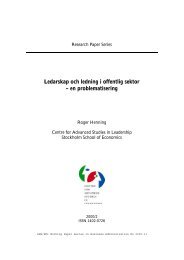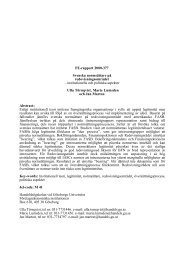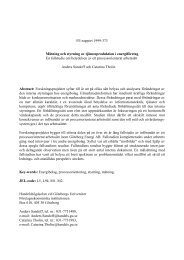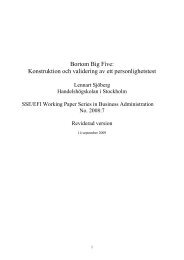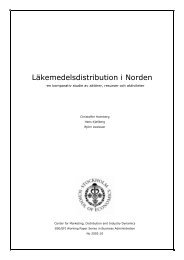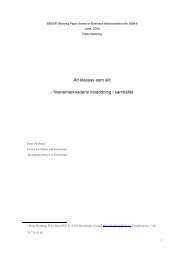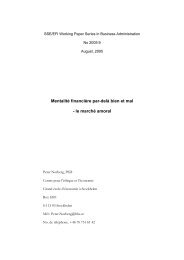personlighetstest i arbetslivet: historik och aktuell forskning
personlighetstest i arbetslivet: historik och aktuell forskning
personlighetstest i arbetslivet: historik och aktuell forskning
You also want an ePaper? Increase the reach of your titles
YUMPU automatically turns print PDFs into web optimized ePapers that Google loves.
center validity. Journal of Applied Psychology, 72, 493-511.<br />
[61]. Ghiselli, E. E. (1966). The validity of occupational aptitude tests. New York: Wiley.<br />
[62]. Goleman, D. (1995). Emotional intelligence. New York: Bantam Books.<br />
[63]. Goleman, D. (1998). Working with emotional intelligence. New York: Bantam Books.<br />
[64]. Goodstein, L. D., & Lanyon, R. I. (1999). Applications of personality assessment to the workplace: A review.<br />
Journal of Business and Psychology, 13, 291-322.<br />
[65]. Grove, W. M., & Meehl, P. E. (1996). Comparative efficiency of informal (subjective, impressionistic) and<br />
formal (mechanical, algorithmic) prediction procedures: The clinical-statistical controversy. Psychology,<br />
Public Policy, and Law, 2, 293-323.<br />
[66]. Gustafsson, J.-E. (1984). A unifying model for the structure of intellectual abilities. Intelligence, 8, 179-<br />
203.<br />
[67]. Gustafsson, J.-E., & Balke, G. (1993). General and specific abilities as predictors of school achievement.<br />
Multivariate Behavioral Research, 28, 407-434.<br />
[68]. Guthke, J., Beckmann, J. F., & Schmidt, G. (2002). Ist an der Graphologie d<strong>och</strong> etwas dran? Untersuchungen<br />
zur Uebereinstimmung von Graphologenurteil und psychometrischen Peroenlichkeitstests./Is<br />
graphology of diagnostic value at all? On the relationship between graphological judgement and psychometric<br />
te sts. Zeitschrift fur Personalpsychologie, 1, 171-176.<br />
[69]. Hampson, S. (1999). State of the art: Personality. Psychologist, 12, 284-288.<br />
[70]. Hardy, T., & Evans, G. L. (1983). Psychology's occult doubles: Psychology and the problem of pseudoscience:<br />
Nelson-Hall.<br />
[71]. Harkness, A. R., & McNulty, J. L. (1994). The Personality Psychopathology Five (PSY-5): Issue from the<br />
pages of a diagnostic manual instead of a dictionary. In S. Strack & M. Lorr (Eds.), Differentiating<br />
normal and abnormal personality (pp. 291-315). New York: Springer.<br />
[72]. Harris, M. M. (1989). Reconsidering the employment interview: a review of recent literature and suggestions<br />
for future research. Personnel Psychology, 40, 691-726.<br />
[73]. Hendrickson, T. M. (1983). Personal profile analysis: a technical manual. Marlow: Thomas International<br />
Systems (Europe) Ltd.<br />
[74]. Henkel, T. G., & Wilmoth, J. N. (1992). Factor analysis of the Personal Profile System. Journal of Experimental<br />
Education, 60, 271-280.<br />
[75]. Hogan, J. C., Hogan, R., & Gregory, S. (1992). Validation of a sales representative selection inventory.<br />
Journal of Business and Psychology, 7, 161-171.<br />
[76]. Hogan, J. C., Hogan, R., & Murtha, T. (1992). Validation of a personality measure of managerial performance.<br />
Journal of Business and Psychology, 7, 225-237.<br />
[77]. Hogan, R. (1994). Trouble at the top. Causes and consequences of managerial incompetence. Consulting<br />
Psychology Journal, 46, 9-15.<br />
[78]. Hogan, R., Curphy, G. J., & Hogan, J. (1994). What we know about leadership: Effectiveness and personality.<br />
American Psychologist, 49, 493-504.<br />
[79]. Hogan, R., Hogan, R., & Roberts, B. W. (1996). Personality measurement and employment decisions.<br />
American Psychologist, 51, 469-477.<br />
32



